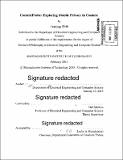ContextProbe : exploring mobile privacy in context
Author(s)
Shih, Fuming
DownloadFull printable version (17.56Mb)
Alternative title
Exploring mobile privacy in context
Other Contributors
Massachusetts Institute of Technology. Department of Electrical Engineering and Computer Science.
Advisor
Hal Abelson.
Terms of use
Metadata
Show full item recordAbstract
My research investigates the following question: What factors affect people's privacy preferences for disclosing data that is collected about them when interacting with mobile applications? Research about information privacy has revealed that there are relations between the role of context and people's expectations about privacy. But it is unclear how those findings can be applied to the ubiquitous environment where mobile apps operate. In order to illuminate this problem I have developed a framework, ContextProbe, which supports both quantitative and qualitative investigations of how user context and other external factors jointly affect people's willingness to disclose personal information to mobile apps. As a consequence of this work, I have learned that people use contextual factors in making decisions about disclosing personal information to apps. Some of the significant privacy contextual factors are people's frequently visited places, specific time slots, who is around, and activities people are engaged in. Although contextual factors help, they do not provide a complete explanation of people's privacy choices. More importantly, I found that other external factors such as purposes of data use and trust in the app itself outweigh contextual factors when considering information disclosure. My study showed that subjects were not aware of context in thinking about disclosure when purpose of data use was presented together in the question. Surprisingly, results drawn from in-situ responses are the exact opposite to previous survey-based approaches on the effect of apps' showing their purpose strings when requesting personal information: showing less information seems to result in greater willingness to disclose. ContextProbe has three major parts: app-building platform, personal data store, and application server. The app-building platform allows experimenters to create apps for ESM studies easily within a visual programming environment. Apps built by ContextProbe can be used to collect sensor data on mobile phones as well as subject-reported data for representing subjects' context. In addition, the apps can probe subjects' privacy preference in-situ with the detected context. The personal data store holds all data collected from subjects' phones and is responsible for sending data automatically to the corresponding application server. It provides a one-stop "dashboard" approach that lets subjects review information collected by the ESM apps. The application server aggregates all collected data in the study and monitors the health status of data collection tasks running on subjects' phone. ContextProbe provides an automatic process for study subjects and experimenters to easily set up personal data store and application server without extra overheads comparing to other existing architectures for ESM studies. My work has opened up the following new questions: how do we best represent the information of privacy-relevant contexts during preference solicitation? And how to balance the trade-offs between sampling in various contexts and the cost of subjects' times? Further research in fields such as behavioral economics that require real-time monitoring of user context, data collection, and in-situ responses might well be conducted using the ContextProbe framework.
Description
Thesis: Ph. D., Massachusetts Institute of Technology, Department of Electrical Engineering and Computer Science, 2015. Cataloged from PDF version of thesis. Includes bibliographical references (pages 145-152).
Date issued
2015Department
Massachusetts Institute of Technology. Department of Electrical Engineering and Computer SciencePublisher
Massachusetts Institute of Technology
Keywords
Electrical Engineering and Computer Science.